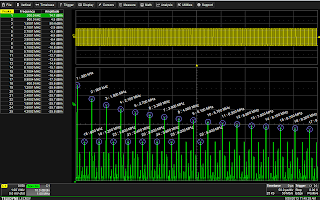 |
| Figure 1: An FFT of a 300-kHz square wave. |
The theory behind FFTs makes an assumption, which is that the time-domain signal being transformed into a frequency-domain spectrum is of infinite duration. Obviously this is not achievable, so the compromise between theory and practice is to view the time-domain signal as consisting of an infinite series of replicas of itself.
In using FFT on a time-domain signal, what's really happening is that the signal is being separated out into its constituent frequency components, essentially diluting its spectral energy in some number of frequency bins corresponding to multiples of the frequency resolution Δf. The capture time, T, determines the frequency resolution of the FFT (Δf = 1/T). Meanwhile, the sampling period and record length set the maximum frequency span that can be obtained (fNyq = Δf*N/2).
All of the above could, of course, be worked out mathematically as a discrete Fourier transform. But to do so even on an eight-sample signal would involve 64 complex multiplications. A signal with 1024 samples balloons out to over 1 million multiplications.
Thus, an FFT operation on an N-point time-domain signal is comparable to passing the signal through a comb filter consisting of a bank of N/2 filters. All of these filters have the same shape and width and are centered at N/2 discrete frequencies, meaning that there are N/2 frequency "bins." The distance in hertz between the centering frequency of any two neighboring bins is always Δf.
 |
| Table 1: FFT window types and their characteristics. |
You can think of choosing a window type along the lines of choosing a camera lens for a given photo. Some experimentation might be in order. As shown by the table, some windows will lend themselves better to certain signal types than others, with tradeoffs between leakage and frequency resolution.
No comments:
Post a Comment